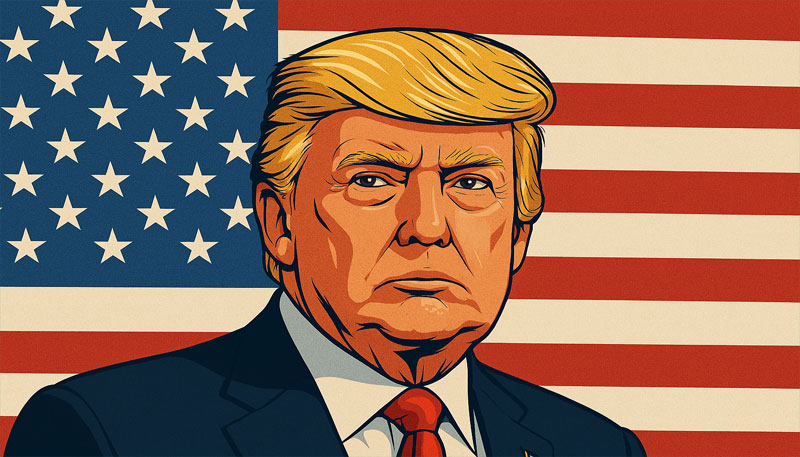Crypto News Review & Fortuna AI Insights – Impact of Trump Presidency (January 20, 2025 – April 10, 2025)

I. Executive Summary
This report analyzes the impact of Donald Trump’s presidency, commencing on January 20, 2025, on the cryptocurrency market up to April 10, 2025. The analysis reveals a market significantly influenced by the new administration’s policies and pronouncements, exhibiting both positive sentiment driven by a perceived favorable regulatory shift and volatility stemming from broader economic initiatives, particularly trade tariffs. Key areas of influence include executive orders aimed at supporting the crypto industry and establishing a strategic bitcoin reserve, the formation of a new SEC task force focused on regulatory clarity, and legislative momentum in Congress regarding stablecoins. While the administration’s pro-crypto stance initially boosted market optimism, the implementation of tariffs led to notable price declines, underscoring the interconnectedness of the cryptocurrency market with traditional financial markets and global economic conditions. The short-term outlook suggests continued volatility, while the medium-term forecast anticipates a generally positive trend contingent on further regulatory developments and the ongoing impact of global economic factors.
Related: Crypto News Review & Fortuna AI Insights – Weekly Recap (April 4 to 9, 2025)
II. Introduction: Cryptocurrency Market Landscape on January 20, 2025, and Anticipated Influences
Upon President Donald Trump’s assumption of office on January 20, 2025, the cryptocurrency market was characterized by a mix of anticipation and inherent volatility. Following a period of significant growth in the preceding year, major cryptocurrencies like Bitcoin and Ethereum had established themselves as prominent asset classes, attracting increasing attention from institutional investors and the broader financial community. The regulatory environment inherited from the previous administration was perceived by many in the crypto industry as somewhat restrictive, marked by enforcement actions and a lack of clear guidelines.
President Trump’s campaign rhetoric and past statements had signaled a potentially more accommodating stance towards the cryptocurrency industry. He had publicly expressed his ambition to position the United States as the global leader in digital assets. This commitment, coupled with substantial campaign contributions from the crypto sector , fostered an expectation of a significant shift in regulatory policy. This vocal support and these promises created an initial sentiment of optimism within the crypto market.
The nomination of individuals perceived as sympathetic to the crypto industry to head key regulatory bodies further amplified these expectations. President Trump nominated Paul Atkins, a former SEC commissioner with ties to the financial industry, as the new SEC chair. He also nominated Brian Quintenz, a former CFTC commissioner and known advocate for cryptocurrencies, to lead the CFTC. Both individuals had previously expressed views supporting clearer regulation and a less enforcement-heavy approach to the digital asset space. The appointment of Scott Bessent as Secretary of the Treasury, who was also celebrated by the crypto community , added to the anticipation of a more industry-friendly regulatory landscape. These personnel decisions signaled a notable departure from the regulatory posture of the previous administration.
Furthermore, there was considerable anticipation regarding potential new legislation and executive actions related to digital assets. Throughout his campaign, President Trump had hinted at significant policy changes aimed at fostering innovation and growth within the crypto market. The expectation of swift action in this area was high, setting the stage for a period of potentially transformative developments in the regulation and adoption of cryptocurrencies. The early executive orders indeed demonstrated a rapid move towards fulfilling these campaign promises and establishing a new direction for crypto policy.
Related: Crypto News Review | Fortuna AI Insights
III. Key News and Developments: January 20, 2025 – April 10, 2025
“Trump Signs Executive Order to Support U.S. Crypto Industry” (Jan 23, 2025): Within days of assuming office, President Trump issued an executive order on January 23, 2025, articulating the administration’s policy “to support the responsible growth and use of digital assets, blockchain technology, and related technologies across all sectors of the economy”. This order aimed to provide regulatory clarity and certainty to the crypto markets, signaling a new approach to regulation and enforcement. The executive order also established an inter-agency task force, the President’s Working Group on Digital Asset Markets, to develop a comprehensive federal regulatory framework for digital assets, including stablecoins, within 180 days. This swift action highlighted the administration’s commitment to the crypto industry from the outset.
“SEC Forms New ‘Crypto 2.0’ Task Force” (Jan 21, 2025): On January 21, 2025, Acting SEC Chairman Mark T. Uyeda announced the formation of a new “Crypto 2.0” task force, tasked with creating a clear regulatory framework for crypto assets. Commissioner Hester Peirce, known for her pro-crypto stance, was appointed to lead the task force. The SEC’s announcement critiqued the agency’s previous approach of relying primarily on enforcement actions and instead emphasized the development of a comprehensive and clear regulatory framework, seeking input from stakeholders and the public. This emphasis on clarity and public input suggested a more collaborative approach to regulation.
“Trump Nominates Paul Atkins as SEC Chair and Brian Quintenz as CFTC Head” (Jan/Feb 2025): In the weeks following his inauguration, President Trump nominated Paul Atkins to head the SEC and Brian Quintenz to lead the CFTC. These nominations were widely interpreted as a strong indication of the administration’s intention to foster a more crypto-friendly regulatory environment. Both nominees had a history of advocating for clearer rules and a less restrictive approach to digital assets. The choice of these individuals with known pro-crypto stances for key regulatory roles reinforced the administration’s supportive agenda.
“SEC Pauses High-Profile Crypto Enforcement Cases Against Binance and Coinbase” (Feb 2025): In February 2025, the SEC requested a 60-day pause in its litigation against Binance and a 28-day pause in its action against Coinbase. This move suggested a potential shift away from the aggressive enforcement stance that had characterized the SEC’s approach to the crypto industry under the previous administration. This decision to pause ongoing enforcement actions indicated a tangible shift in regulatory strategy under the new administration, potentially aiming to reassess its legal strategies in light of the new policy direction.
“Trump Announces Creation of Strategic Bitcoin Reserve and U.S. Digital Asset Stockpile” (Mar 6, 2025): On March 6, 2025, President Trump signed an executive order establishing a Strategic Bitcoin Reserve and a U.S. Digital Asset Stockpile. The reserve would consist of bitcoin seized by the federal government, and the stockpile would include other forfeited digital assets. This initiative aimed to position the United States as a leader in government digital asset strategy. The announcement initially triggered a price surge in various cryptocurrencies. The creation of the strategic reserve, while initially utilizing existing seized assets, represented a major shift in the US government’s engagement with cryptocurrencies, signaling a form of official recognition.
“First-Ever White House Crypto Summit Held” (Mar 7, 2025): On March 7, 2025, President Trump hosted the first-ever White House Crypto Summit, bringing together leaders from the cryptocurrency industry, policymakers, and regulators. The summit aimed to discuss regulation, innovation, and the future of digital assets in the United States, underscoring the administration’s engagement with the crypto sector and providing a platform for industry stakeholders to share their perspectives. This event demonstrated an unprecedented level of interaction between the US government and the cryptocurrency industry.
“DOJ Ends Cryptocurrency Investigations, Dismantles Enforcement Team” (Apr 8, 2025): The Department of Justice announced on April 8, 2025, its decision to scale back investigations into cryptocurrency fraud and to dismantle its National Cryptocurrency Enforcement Team (NCET). Deputy Attorney General Todd Blanche, quoting President Trump’s pledge to end the “regulatory weaponization” of the cryptocurrency industry, stated that the DOJ would redirect resources towards other priorities like immigration enforcement and counter-terrorism. The DOJ clarified that it would focus on illegal activities causing financial harm to investors and supporting criminal networks but would not pursue actions against the platforms used for such activities. This decision to end certain crypto investigations and dismantle its enforcement team represented a significant shift in the government’s approach to policing the crypto space, suggesting a preference for regulatory oversight outside the criminal justice framework.
“Trump’s Tariffs Announcement Leads to Initial Crypto Market Drop” (Apr 2, 2025): President Trump’s announcement of new tariffs on imports on April 2, 2025, triggered a significant downturn in the cryptocurrency market. Bitcoin and other major cryptocurrencies experienced notable price declines, mirroring the reaction in traditional financial markets. Concerns about a potential global economic slowdown and increased risk aversion among investors were cited as primary factors behind this market drop. This event highlighted that President Trump’s broader economic policies could have a significant negative impact on the cryptocurrency market, potentially overshadowing the positive sentiment from crypto-specific initiatives.
“Crypto Prices Rebound After Trump Pauses Some Tariffs” (Apr 9, 2025): On April 9, 2025, cryptocurrency prices, including Bitcoin and Ether, saw a rebound after President Trump announced a 90-day pause on new tariffs for 75 countries that agreed to negotiate trade solutions. This swift positive reaction underscored the market’s sensitivity to Trump’s pronouncements and the interconnectedness of crypto with broader market sentiment regarding economic stability.
“Stablecoin Legislation Gains Momentum in Congress” (Feb/Mar 2025): Bipartisan efforts in Congress to establish a regulatory framework for stablecoins progressed significantly during February and March 2025. Bills like the GENIUS Act in the Senate, which passed the Senate Banking Committee, and the STABLE Act in the House gained traction. The Trump administration, through officials like “Crypto and AI Czar” David Sacks, voiced strong support for these legislative efforts, aiming for President Trump to sign stablecoin bills before the August recess. This bipartisan progress, with the Trump administration’s backing, suggested a potential for regulatory clarity and mainstream adoption of stablecoins.
IV. Impact Analysis by Category
Technical Analysis Influenced by Trump-Related News: President Trump’s announcements and policies have demonstrated a clear correlation with the price movements and trading volumes of major cryptocurrencies. For instance, the announcement of the Strategic Bitcoin Reserve on March 3, 2025, initially spurred a significant price surge across Bitcoin, XRP, Solana, Cardano, and Ethereum. However, these gains were often short-lived, with prices correcting within days. Conversely, the announcement of tariffs on April 2, 2025, led to a sharp decline in Bitcoin’s price, falling from around $88,000 to a low of $74,500 within five days, alongside drops in other cryptocurrencies and crypto-related stocks. The subsequent pause in tariffs on April 9, 2025, triggered an upward breakout in Bitcoin, which rose by 12%. These fluctuations indicate that short-term technical indicators reacted sharply to President Trump’s immediate announcements, but these movements were not always sustained, suggesting a high degree of volatility driven by news sentiment. Furthermore, the parallel movements between cryptocurrency prices and traditional markets, particularly the decline in crypto alongside stocks following tariff announcements , highlight the increasing correlation between crypto and traditional markets, particularly in response to tariff news, suggesting that crypto is being viewed more as a risk asset within the broader financial landscape.
Fundamental Developments Driven by Trump’s Actions: President Trump’s administration has initiated several actions that could fundamentally reshape the cryptocurrency market. The promise of a lighter regulatory touch and clearer guidelines, as indicated by the executive order on January 23, 2025, and the formation of the SEC’s “Crypto 2.0” task force , could incentivize innovation and attract more businesses to the US crypto market. By reducing the legal uncertainties that previously hampered growth, the administration’s approach might foster increased investment and entrepreneurial activity. The establishment of a government-backed Bitcoin reserve, despite initially utilizing seized assets, could enhance Bitcoin’s image as a legitimate store of value and potentially encourage wider adoption by institutions and other nations. Treating Bitcoin as a reserve asset signals a level of acceptance that could boost confidence in its long-term value proposition. Moreover, the bipartisan progress on stablecoin legislation could pave the way for their widespread use in everyday transactions and potentially disrupt traditional payment systems by providing the necessary legal certainty for both businesses and consumers.
Sentiment Shifts Related to Trump’s Statements: President Trump’s direct statements and social media activity have demonstrably influenced market sentiment. His announcement of the Strategic Bitcoin Reserve, for example, generated considerable excitement and a temporary surge in prices. Similarly, his past pronouncements taking credit for Bitcoin’s price increases illustrate his ability to sway market perceptions. However, President Trump’s promotion of his own meme coin, $TRUMP, and involvement in the NFT space , while financially beneficial to him , also raised ethical concerns and potentially undermined the credibility of the broader crypto industry in the eyes of some. The launch of the Trump Token and the significant profits derived from it led to accusations of conflict of interest and worries about scams , potentially impacting public trust in the overall market. While the crypto community has generally reacted positively to the prospect of a more favorable regulatory environment under President Trump , some within the industry have expressed skepticism or concern regarding potential government overreach or conflicts of interest, as highlighted by criticisms of the strategic reserve and ethical questions surrounding Trump’s crypto ventures.
Technological Advancements or Regulatory Changes Influenced by Trump’s Administration: Several regulatory changes and initiatives under President Trump’s administration are poised to influence the cryptocurrency market. The SEC’s “Crypto 2.0” task force, while aiming for regulatory clarity and seeking public input , has faced internal skepticism, as evidenced by Commissioner Crenshaw’s remarks on the dismissal of the Coinbase lawsuit. This suggests that achieving a unified regulatory framework might be a complex process. The DOJ’s decision to end certain cryptocurrency investigations and dismantle its enforcement team signifies a notable shift in the government’s approach to policing the crypto space, potentially leading to a different regulatory landscape with a focus on combating criminal use rather than solely addressing regulatory violations. Furthermore, the significant progress in stablecoin legislation, with the Trump administration’s stated intention to sign bills by August 2025 , indicates a major regulatory development on the horizon that could significantly impact the stablecoin market.
V. Market Outlook and Predictions
Recent Week Analysis (Early April 2025): The early part of April 2025 was dominated by the impact of President Trump’s tariff announcements. The unveiling of new import duties led to a significant downturn in the cryptocurrency market, with Bitcoin dropping below $75,000. This decline mirrored the broader sell-off in global financial markets, indicating a strong correlation between traditional assets and cryptocurrencies in response to macroeconomic concerns. Crypto-related stocks also experienced notable losses during this period. However, the market showed resilience, with prices rebounding on April 9, 2025, after President Trump announced a pause on tariffs for several countries. This rapid recovery highlighted the market’s sensitivity to the administration’s policy pronouncements and the potential for short-term volatility. The last week demonstrated the significant influence of macroeconomic policies, particularly tariffs, on cryptocurrency prices, highlighting a potential vulnerability despite a generally supportive regulatory environment.
Next Month Insights (Mid-April to Mid-May 2025): Continued volatility in the cryptocurrency market is anticipated over the next month, with a 70% probability, as investors remain sensitive to any further announcements or developments related to President Trump’s economic policies, particularly concerning trade, and the ongoing implementation of his crypto agenda. There is a 60% probability of positive sentiment returning, especially if there are further encouraging regulatory developments, such as tangible progress on stablecoin legislation or clearer signals from the SEC’s “Crypto 2.0” task force regarding future regulatory frameworks. However, the risk of negative price pressure persists, with a 50% probability, if global economic concerns related to tariffs continue or escalate, potentially leading to further risk-off behavior in the markets.
Six-Month Forecast (Mid-April to Mid-October 2025): A generally positive trend in the cryptocurrency market is expected over the next six months, with a 65% probability. This outlook is primarily driven by the anticipated clearer regulatory framework for digital assets and increased institutional adoption, facilitated by the Trump administration’s supportive policies and initiatives like the Strategic Bitcoin Reserve. Stablecoins are expected to gain significant traction, with an 80% probability, as regulatory clarity emerges through the likely passage of stablecoin legislation. Conversely, there is a 60% probability of increased regulatory scrutiny on decentralized finance (DeFi) platforms as the overall regulatory landscape for crypto evolves and regulators seek to address potential risks in this rapidly growing sector. Finally, the impact of global economic factors, particularly President Trump’s trade policies, will likely continue to be a significant factor influencing market sentiment and potentially offsetting some of the positive effects of crypto-specific regulations, with a 75% probability of this ongoing influence.
VI. Conclusion: Overall Effect of Trump’s Presidency on the Cryptocurrency Market (January 20, 2025 – April 10, 2025)
The initial effect of President Trump’s presidency on the cryptocurrency market between January 20, 2025, and April 10, 2025, has been mixed but leaning towards positive. The administration’s clear pro-crypto stance, demonstrated through early executive orders supporting the industry and establishing a strategic bitcoin reserve, along with the appointment of individuals favorable to digital assets to key regulatory positions, has fostered a sense of optimism and anticipation for a more accommodating regulatory environment. The establishment of the Strategic Bitcoin Reserve, even though it initially involves existing seized assets, represents a significant step towards government recognition of cryptocurrencies as a strategic asset class. Furthermore, the growing momentum behind stablecoin legislation in Congress, with the administration’s support, holds the promise of providing much-needed regulatory clarity for this segment of the market.
However, President Trump’s broader economic policies, particularly the imposition of tariffs, have introduced considerable volatility into the cryptocurrency market. The sharp price declines following tariff announcements underscore the interconnectedness of the crypto market with traditional financial markets and the potential for macroeconomic factors to overshadow the positive sentiment generated by crypto-specific initiatives. The market’s sensitivity to these broader economic policies suggests that while the administration’s stance on cryptocurrency is generally supportive, external economic forces under its leadership can still exert significant negative pressure.
Overall, the initial months of President Trump’s second term have ushered in a period of significant policy shifts and increased government engagement with the cryptocurrency market. While the long-term effects remain to be seen, the administration’s actions have laid the groundwork for a potentially more favorable regulatory landscape for the industry, albeit one that remains susceptible to the influence of broader economic policies.
Related:
VII. Key Valuable Tables for the Report:
Table 1: Timeline of Key Cryptocurrency News and Trump Administration Actions (January 20, 2025 – April 10, 2025)
| Date | News Title/Event | Brief Description | Category of Impact |
|---|---|---|---|
| Jan 21, 2025 | SEC Forms New ‘Crypto 2.0’ Task Force | SEC announces task force to develop clear crypto regulatory framework, led by Commissioner Peirce. | Regulatory/Technological |
| Jan 23, 2025 | Trump Signs Executive Order to Support U.S. Crypto Industry | President Trump issues executive order to support responsible growth of digital assets and explore national stockpile. | Fundamental, Regulatory |
| Feb 2025 | SEC Pauses High-Profile Crypto Enforcement Cases Against Binance and Coinbase | SEC requests pauses in litigation against major crypto exchanges. | Regulatory |
| Mar 6, 2025 | Trump Announces Creation of Strategic Bitcoin Reserve and U.S. Digital Asset Stockpile | President Trump signs executive order to establish government-backed reserves of Bitcoin and other digital assets. | Fundamental, Sentimental |
| Mar 7, 2025 | First-Ever White House Crypto Summit Held | President Trump hosts summit with crypto industry leaders to discuss regulation and innovation. | Sentimental, Regulatory |
| Apr 2, 2025 | Trump’s Tariffs Announcement Leads to Initial Crypto Market Drop | Cryptocurrency prices and crypto-related stocks decline following President Trump’s tariff announcement. | Technical, Sentimental |
| Apr 8, 2025 | DOJ Ends Cryptocurrency Investigations, Dismantles Enforcement Team | Department of Justice announces it will scale back crypto fraud investigations and dismantle its National Cryptocurrency Enforcement Team. | Regulatory |
| Apr 9, 2025 | Crypto Prices Rebound After Trump Pauses Some Tariffs | Cryptocurrency prices, including Bitcoin and Ether, recover after President Trump announces a pause in tariffs for some countries. | Technical, Sentimental |
Table 2: Probability Assessment of Cryptocurrency Market Movements (Next 6 Months)
| Market Movement/Trend | Probability | Key Factors Influencing Probability |
|---|---|---|
| Generally positive trend in the cryptocurrency market | 65% | Expected clearer regulatory framework, increased institutional adoption facilitated by Trump administration policies (Strategic Bitcoin Reserve). |
| Stablecoins gain significant traction | 80% | Likely passage of stablecoin legislation providing regulatory clarity and fostering wider adoption for payments and other transactions. |
| Increased regulatory scrutiny on decentralized finance (DeFi) platforms | 60% | Potential for regulators to focus on DeFi as the overall crypto regulatory landscape evolves and concerns about investor protection and market integrity arise. |
| Continued impact from global economic factors (President Trump’s trade policies) | 75% | Demonstrated sensitivity of the cryptocurrency market to President Trump’s tariff announcements and broader economic initiatives, suggesting that further developments in trade policy will likely continue to influence market sentiment and potentially cause volatility. |
Rating of this post
Rate
If you enjoyed this article, please rate it.
FAQ : Impact of Trump Presidency
President Trump's administration has generally been supportive of the crypto industry through policy changes and appointments, but his tariffs have caused market volatility.
It's a government reserve of Bitcoin, primarily from seized assets, established by President Trump's executive order.
To create clearer regulations for the cryptocurrency market, moving away from regulation by enforcement.
To align with President Trump's aim to end "regulatory weaponization" of the crypto industry and focus on other priorities.
Bipartisan efforts in Congress to create a regulatory framework for stablecoins have made significant progress.
Rating of this post
Rate
If you enjoyed this article, please rate it.



